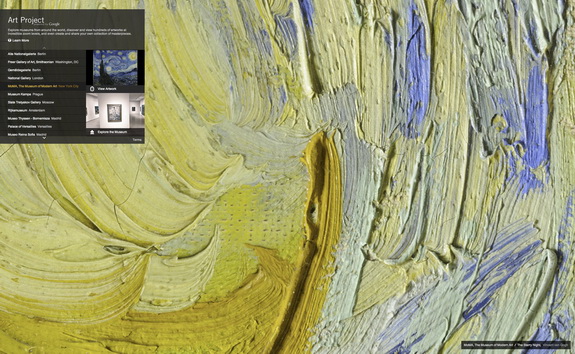ARTISTS. On Feb. 1, Google unveiled the Art Project. It enables people around the world to discover and view more than 1,000 artworks online in extraordinary detail. For example, the image shown below is a close-up of Van Gogh’s “The Starry Night” as you can view it on the Art Project page for the Museum of Modern Art (MoMA). When you visit the page, you can also see a MoMA-produced video featuring visitors’ comments on the paintings.
MoMA is one of the 17 art museums from nine countries that have collaborated with Google over the past 18 months to launch the Art Project. The project will enable anyone around the world to take virtual tours inside the museums’ galleries and learn about the history and artists behind many of the world’s most valuable works.
I’m writing about the Google Art Project here, because it’s further evidence of how advances in imaging technology are changing the way art will be viewed and shared in the future. This introductory project just hints at what will be possible in the years ahead.
Some imaging professionals have already established new careers for themselves by helping museums create very detailed, high-resolution, color-accurate scans of valuable artworks for their archives.
By using the latest image-capture and assembly tools, the Google Art Project is going one step further. The project gives us online access to images with super-high ‘gigapixel’ resolutions. Some images of the artworks contain around 7 billion pixels, which is why you can pan around some paintings and zoom in to see brushstroke-level detail from a vantage point that was previously only seen by art restorers.
To get started, go to the Google Art Project home page (www.googleartproject.com) and choose which museum you’d like to “visit.” Then, choose either the “Explore the Museum” or “View Artwork” option.
The 17 participating museums are located in 11 cities in 9 countries:
- The Frick Collection (New York)
- The Metropolitan Museum of Art (New York)
- The Museum of Modern Art (New York)
- Freer Gallery of Art, Smithsonian (Washington, DC)
- National Gallery (London, UK)
- Tate Britain (London, UK)
- Museo Reina Sofia (Madrid, Spain)
- Museo Thyssen-Bornemisza (Madrid, Spain)
- Alte Nationalgalerie (Berlin, Germany)
- Gemaldegalerie (Berlin, Germany)
- Rijksmuseum (Amsterdam, The Netherlands)
- Van Gogh Museum (Amsterdam, The Netherlands)
- The State Hermitage Museum (St. Petersburg, Russia)
- State Tretyakov Gallery (Moscow, Russia)
- Palace of Versailles (France)
- Uffizi Gallery (Florence, Italy)
- Museum Kampa (Prague, Czech Republic)
Explore
The “Explore” option uses Google Street View technology to let you explore a museum gallery the way you would use the Street View in Google Maps. A specially designed Street View “trolley” (below) took 360-degree images of the interiors of 385 selected galleries within the museums.
 These images were then stitched together into “panoramas” that enable smooth navigation of each room. Some paintings on the walls appear blurred. In most cases, that’s because the museum does not own the copyright to those images.
These images were then stitched together into “panoramas” that enable smooth navigation of each room. Some paintings on the walls appear blurred. In most cases, that’s because the museum does not own the copyright to those images.
View and Learn
Each of the 17 museums selected one artwork to be photographed at super-high resolution with ‘gigapixel’ photo-capturing technology. The captures are so detailed, you can study details of the brushwork and patina beyond what is possible with the naked eye.
In addition, the museums provided high-resolution images for more than 1,000 works of art. When used with the Google Art Project’s custom-built zoom viewer, you can discover minute aspects of paintings you might never have seen up close before, such as the miniaturized people in the river of El Greco’s “View of Toledo” or individual dots in Seurat’s “Grandcamp Evening.”
You can learn more about each art work through the Google Scholar, Google Docs, and YouTube video links provided with each sidebar info panel.
Each museum chose which collections to feature and what type of information to share about each piece. They also recommended which angles should be used during the image-capture process.
Collect and Share
If you have a Google account, you can save specific views of any of the artworks to build your collections. Comments can be added to each painting and the whole collection can then be shared with friends, family, or fellow art students. The integrated Goog.gl URL shortener can be used to share unique links to your collections via email or other web services.
What’s Next?
Now that the project has been introduced, it will be interesting to gauge the public’s reaction. According to Google, “The project you see today is the very first incarnation, and we may well add more artworks and new rooms in the future.”
The Art Project was initiated by a group of Google employees who were passionate about making art more accessible online. Amit Sood, the Google employee who heads the Art Project, believes they have created “what we hope will be a fascinating resource for art lovers, students, and casual museum-goers alike—inspiring them to one day visit the real thing.”
Many of the participating museums feel the same way. As Thomas Campbell, director of The Metropolitan Museum of Art puts it, “The Google Art Project coincides with a variety of Met initiatives that demystify the museum through digital means by sharing our collections and ongoing work with a broader online public around the world. Most important, these projects encourage people to visit museums and come face-to-face with great works of art.”
Dr. Nicholas Penny, director of the National Gallery, believes, “The Google Art Project is a powerful example of how digital technology can help art institutions work in partnership to reach out globally to new audiences and enable works of art to be explored in depth and with stunning clarity.”
LINK
VIDEO


